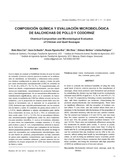| dc.rights.license | http://creativecommons.org/licenses/by-nc-sa/3.0/ve/ | |
| dc.contributor.author | Cori de Mendoza, Marta Elena | |
| dc.contributor.author | De Basilio, Vasco | |
| dc.contributor.author | Figueroa Ruiz, Rosana | |
| dc.contributor.author | Rivas, Nilo | |
| dc.contributor.author | Martínez, Shimazú | |
| dc.contributor.author | Rodríguez, Iraima | |
| dc.date.accessioned | 2014-04-09T11:49:12Z | |
| dc.date.available | 2014-04-09T11:49:12Z | |
| dc.date.issued | 2014-04-09T11:49:12Z | |
| dc.identifier.issn | 0798-2259 | |
| dc.identifier.uri | http://www.saber.ula.ve/handle/123456789/38365 | |
| dc.description.abstract | Con el objeto de evaluar la factibilidad técnica de usar la carne
de codorniz (Coturnix coturnix japonica) macho en la elaboración
de salchichas, se formularon y elaboraron estos productos
cárnicos sustituyendo la carne de pierna y muslo de pollo
por carne deshuesada mecánicamente (CDM) de codorniz en
0; 10; 20; 30 y 40% (T1, T2, T3, T4 y T5, respectivamente), utilizando
un diseño completamente aleatorizado, con tres repeticiones
por tratamiento, caracterizando los productos fisicoquímica
y microbiológicamente. No se encontraron diferencias estadísticamente
significativas, salvo en el contenido de humedad,
donde la salchicha sin CDM fue inferior al resto de los tratamientos,
y en la proporción de cenizas donde hubo una tendencia
al incremento con el aumento de la proporción de
CDM, tendencia que coincidió particularmente con los contenidos
de hierro y calcio. El contenido de grasa estuvo entre 5,12
y 5,51%, siendo inferiores a valores encontrados para salchichas
comerciales de aves, de 22,22 y 16%; el contenido proteico
osciló entre 13,41 y 13,74%. No se encontraron diferencias
estadísticamente significativas entre los cinco tratamientos
para aerobios mesófilos, S. aureus ni levaduras, obteniendo
para todos los tratamientos contajes menores a 10 ufc/g
para mohos y para E. coli, comprobándose además la ausencia
de Salmonella. Se concluye que cualquiera de las formulaciones
propuestas pueden ser ofrecidas sin poner en riesgo la
salud del consumidor por contaminación microbiológica, siendo
una fuente de proteína, proporcionando un bajo contenido
de grasa para aquellos consumidores que requieran que se
cumpla con esta condición adicional y siendo además los tratamientos de mayor proporción de CDM una fuente adicional de hierro y calcio. | es_VE |
| dc.language.iso | es | es_VE |
| dc.rights | info:eu-repo/semantics/openAccess | |
| dc.subject | Carne deshuesada mecánicamente | es_VE |
| dc.subject | Salchicha | es_VE |
| dc.subject | Codorniz | es_VE |
| dc.subject | Grasa | es_VE |
| dc.subject | Pollo | es_VE |
| dc.title | Composición química y evaluación microbiológica de salchichas de pollo y codorniz | es_VE |
| dc.title.alternative | Chemical composition and microbiological evaluation of chicken and quail sausages | es_VE |
| dc.type | info:eu-repo/semantics/article | |
| dc.description.abstract1 | In order to evaluate the technical feasibility of using the male
quail meat (Coturnix coturnix japonica) in the manufacture of
sausages, these meat products were formulated and produced
by substituting the chicken leg and thigh meat for mechanically
deboned meat (MDM) of quail in 0, 10, 20, 30 and 40% (T1, T2,
T3, T4 and T5, respectively) following a totally randomized design,
with three repetitions per treatment, characterizing the
products physicochemically and microbiologically. There were
no significant differences, with the exception of moisture content
where T1 was lower, and ash content where there was a
tendency to the increment with the increase of the proportion of
MDM, coincident tendency with the iron and calcium contents.
The fat content was between 5.12 and 5.51%, and was lower
than the values reported by commercial poultry sausages of
22.22 and 16%; the protein content oscillated between 13.41
and 13.74%. There were not statistically differences among the
five treatments for aerobic plate counts, S. aureus or yeasts,
obtaining for all the treatments counts lower than 10 ufc/g for
molds and for E. coli and proving the absence of Salmonella. It
can be concluded that any treatment can be offer to the consumers,
without risking their health by microbiological contamination,
as well as being an additional source of protein, providing
a low fat content to those consumers that require this additional condition, and being the treatments with high proportion of MDM an additional source of iron and calcium. | es_VE |
| dc.description.colacion | 11-17 | es_VE |
| dc.description.email | martacori@gmail.com | es_VE |
| dc.identifier.depositolegal | 199102ZU46 | |
| dc.publisher.pais | Venezuela | es_VE |
| dc.subject.institucion | Universidad del Zulia (LUZ) | es_VE |
| dc.subject.institucion | Universidad de Los Andes (ULA) | es_VE |
| dc.subject.keywords | Mechanically deboned meat | es_VE |
| dc.subject.keywords | Sausage | es_VE |
| dc.subject.keywords | Quail | es_VE |
| dc.subject.keywords | Fat | es_VE |
| dc.subject.keywords | Chicken | es_VE |
| dc.subject.publicacionelectronica | Revista Científica | |
| dc.subject.seccion | Revista Científica: Ciencia y Tecnología de los Alimentos | es_VE |
| dc.subject.thematiccategory | Medio Ambiente | es_VE |
| dc.subject.tipo | Revistas | es_VE |
| dc.type.media | Texto | es_VE |


